Thermodynamic Guidelines for the Mechanosynthesis or Solid-State Synthesis of MnFe2O4 at Relatively Low Temperatures
Abstract
1. Introduction
2. Methods
2.1. Thermodynamic Modelling
2.2. Experimental Methods
3. Thermodynamic Guidelines
3.1. Synthesis from Oxide and/or Metallic Precursors
3.2. Synthesis from Carbonate + Carbonate or Carbonate + Oxide Precursor Mixtures
3.3. Synthesis from Hydroxide + Oxide or Hydroxide + Oxyhydroxide Precursor Mixtures
4. Experimental Validation
4.1. Synthesis from Oxide Mixtures
4.2. Synthesis from Carbonate + Oxide Mixtures
5. Conclusions
Author Contributions
Funding
Data Availability Statement
Conflicts of Interest
References
- Pérez-Vega, R.; Abad, A.; García-Labiano, F.; Gayán, P.; de Diego, L.F.; Izquierdo, M.T.; Adánez, J. Chemical Looping Combustion of gaseous and solid fuels with manganese-iron mixed oxide as oxygen carrier. Energy Convers. Manag. 2018, 159, 221–223. [Google Scholar] [CrossRef]
- Abian, M.; Abad, A.; Izquierdo, M.T.; Gayan, P.; de Diego, L.F.; Garcia-Labiano, F.; Adanez, J. Titanium substituted manganese-ferrite as an oxygen carrier with permanent magnetic properties for chemical looping combustion of solid fuels. Fuel 2017, 195, 38–48. [Google Scholar] [CrossRef]
- Sukmarani, G.; Kusumaningrum, R.; Noviyanto, A.; Fauzi, F.; Habieb, A.M.; Amal, M.I.; Rochman, N.T. Synthesis of manganese ferrite from manganese ore prepared by mechanical milling and its application as an inorganic heat-resistant pigment. J. Mat. Res. Technol. 2020, 9, 8497–8506. [Google Scholar] [CrossRef]
- Arjmand, M.; Leion, H.; Mattisson, T.; Lyngfelt, A. Investigation of different manganese ores as oxygen carriers in chemical-looping combustion (CLC) for solid fuels. Appl. Energy 2014, 113, 1883–1894. [Google Scholar] [CrossRef]
- Kang, Y.B.; Jung, I.H. Thermodynamic modelling of oxide phases in the Fe–Mn–O system. J. Phys. Chem. Solids 2016, 98, 237–246. [Google Scholar] [CrossRef]
- Kjellqvist, L.; Selleby, M. Thermodynamic assessment of the Fe-Mn-O system. J. Phase Equilibria Diffus. 2010, 31, 113–134. [Google Scholar] [CrossRef]
- Zhang, L.; Wang, Y.; Liu, B.; Wang, J.; Han, G.; Zhang, Y. Characterization and property of magnetic ferrite ceramics with interesting multilayer structure prepared by solid-state reaction. Ceram. Int. 2021, 47, 10927–10939. [Google Scholar] [CrossRef]
- Liu, B.; Zhang, Y.; Wang, J.; Lu, M.; Peng, Z.; Li, G.; Jiang, T. Investigations on the MnO2-Fe2O3 system roasted in air atmosphere. Adv. Powder Technol. 2017, 28, 2167–2176. [Google Scholar] [CrossRef]
- Chen, D.; Zhang, Y.; Kang, Z. A low temperature synthesis of MnFe2O4 nanocrystals by microwave-assisted ball-milling. Chem. Eng. J. 2013, 215–216, 235–239. [Google Scholar] [CrossRef]
- Levy, D.; Pastero, L.; Hoser, A.; Viscovo, G. Thermal expansion and cation partitioning of MnFe2O4 (Jacobsite) from 1.6 to 1276 K studied by using neutron powder diffraction. Solid State Commun. 2015, 201, 15–19. [Google Scholar] [CrossRef]
- Zhang, Z.J.; Wang, Z.L.; Chakoumakos, B.C.; Yin, J.S. Temperature dependence of cation distribution and oxidation state in magnetic Mn-Fe ferrite nanocrystals. J. Am. Chem. Soc. 1998, 120, 1800–1804. [Google Scholar] [CrossRef]
- Zhou, Z.; Du, Y.; Xi, S.; Xu, Z. Spinel manganese ferrites for oxygen electrocatalysis: Effect of Mn valency and occupation site. Electrocatalysis 2018, 9, 287–292. [Google Scholar] [CrossRef]
- Mallesh, S.; Srinivas, V. A comprehensive study on thermal stability and magnetic propertoies of MnZn-ferrite nanoparticles. J. Magn. Magn. Mater. 2019, 475, 290–303. [Google Scholar] [CrossRef]
- Sepelak, V.; Duvel, A.; Wilkening, M.; Becker, K.D.; Heitjans, P. Mechanochemical reactions and syntheses of oxides. Chem. Soc. Rev. 2013, 42, 7507–7522. [Google Scholar] [CrossRef]
- Sepelak, V.; Bergmann, I.; Feldhoff, A.; Heitjans, P.; Krumeich, F.; Menzel, D.; Litterst, F.J.; Campbell, S.J.; Becker, K.D. Nanocrystalline Nickel Ferrite, NiFe2O4: Mechanosynthesis, Nonequilibrium Cation Distribution, Canted Spin Arrangement, and Magnetic Behavior. J. Phys. Chem. C 2007, 11, 5026–5033. [Google Scholar] [CrossRef]
- Mahmoud, M.H.; Hamdeh, H.H.; Ho, J.C.; O’Shea, M.J.; Walker, J.C. Moessbauer studies of manganese ferrite fine particles processed by ball-milling. J. Magn. Magn. Mat. 2000, 220, 139–146. [Google Scholar] [CrossRef]
- Padella, F.; Alvani, C.; La Barbera, A.; Ennas, G.; Liberatore, R.; Varsano, F. Mechanosynthesis and process characterization of nanostructured manganese ferrite. Mater. Chem. Phys. 2005, 90, 172–177. [Google Scholar] [CrossRef]
- Bolarín-Miró, A.M.; Vera-Serna, P.; Sánchez-De Jesús, F.; Cortés-Escobedo, C.A.; Martínez-Luevanos, A. Mechanosynthesis and magnetic characterisation of nanocrystalline manganese ferrites. J. Mater. Sci. Mater. Electron. 2011, 22, 1046–1052. [Google Scholar] [CrossRef]
- Berbenni, V.; Marinia, A.; Profumo, A.; Cucca, L. The Effect of High Energy Milling on the Solid State Synthesis of MnFe2O4 from Mixtures of MnO–Fe2O3 and Mn3O4–Fe2O3. Z. Naturforsch. B 2003, 58, 415–422. [Google Scholar] [CrossRef]
- Şimşek, T.; Akansel, S.; Özcan, Ş.; Ceylan, A. Synthesis of MnFe2O4 nanocrystals by wet-milling under atmospheric conditions. Ceram. Int. 2014, 40, 7953–7956. [Google Scholar] [CrossRef]
- Ding, J.; Mc Cormick, P.G.; Street, R. Formation of spinel Mn-ferrite during mechanical alloying. J. Magn. Magn. Mat. 1997, 171, 309–314. [Google Scholar] [CrossRef]
- Luo, J. Preparation of manganese ferrite powders by mechanochemical process. Adv. Mat. Res. 2011, 284, 2268–2271. [Google Scholar] [CrossRef]
- Lazarevic, Z.Z.; Jovalekic, C.; Recnik, A.; Ivanovski, V.N.; Mitric, M.; Romcevi, M.J.; Paunovic, N.; Cekic, B.Ð.; Romcevi, N.Z. Study of manganese ferrite powders prepared by a soft mechanochemical route. J. Alloys Compd. 2011, 509, 9977–9985. [Google Scholar] [CrossRef]
- Behera, C.; Choudhary, R.N.P.; Das, P.R. Size dependent electrical and magnetic properties of mechanically-activated MnFe2O4 nanoferrite. Ceram. Int. 2015, 41, 13042–13954. [Google Scholar] [CrossRef]
- Osmokrovic, P.; Jovalekic, C.; Manojlovic, D.; Pavlovic, M.B. Synthesis of MnFe2O4 nanoparticles by mechanochemical reaction. J. Optoelectron. Adv. Mater. 2006, 8, 312–324. [Google Scholar]
- Antunes, I.; Ruivo, L.C.M.; Tarelho, L.A.C.; Yaremchenko, A.A.; Kovalevsky, A.V.; Frade, J.R. MnFe2O4-based spinels by mechanochemical and thermochemical reaction of siderite and MnO2 powder mixtures. Ceram. Int. 2023, 49, 19495–19504. [Google Scholar] [CrossRef]
- Aslibeiki, B.; Kameli, P.; Salamati, H.; Eshraghi, M.; Tahmasebi, T. Superspin glass state in MnFe2O4 nanoparticles. J. Magn. Magn. Mat. 2010, 322, 2929–2934. [Google Scholar] [CrossRef]
- Muroi, M.; Street, R.; McCormick, P.G.; Amighian, J. Magnetic properties of ultrafine MnFe2O4 powders prepared by mechanochemical processing. Phys. Rev. B 2001, 63, 184414. [Google Scholar] [CrossRef]
- Yokokawa, H.; Kawada, T.; Dokiya, M. Construction of chemical potential diagrams for metal-metal-nonmetal systems: Applications to the decomposition of double oxides. J. Amer. Ceram. Soc. 1989, 72, 2104–2110. [Google Scholar] [CrossRef]
- Yokokawa, H. Generalised Chemical Potential Diagram and Its Applications to Chemical Reactions at Interfaces between Dissimilar Materials. J. Phase Equilibria 1999, 20, 258–287. [Google Scholar] [CrossRef]
- Yokokawa, H.; Sakai, N.; Kawada, T.; Dokiya, M. Thermodynamic stabilities of perovskite oxides for electrodes and other electrochemical materials. Solid State Ion. 1992, 52, 43–46. [Google Scholar] [CrossRef]
- Yokokawa, H. Understanding materials compatibility. Annu. Rev. Mater. Res. 2003, 33, 581–610. [Google Scholar] [CrossRef]
- Yokokara, H.; Kawada, T.; Dokiya, M. Generalized chemical potential diagrams for metal-oxygen-sulfur systems. Denki Kagaku 1988, 56, 751–756. [Google Scholar]
- Vitorino, N.M.D.; Kovalevsky, A.V.; Ferro, M.C.; Abrantes, J.C.C.; Frade, J.R. Design of NiAl2O4 cellular monoliths for catalytic applications. Mater. Des. 2017, 117, 332–337. [Google Scholar] [CrossRef]
- Ruivo, L.C.M.; Pio, D.T.; Yaremchenko, A.A.; Tarelho, L.C.A.; Frade, J.R.; Kantarelis, E.; Engvall, K. Iron-based catalyst (Fe2-xNixTiO5) for tar decomposition in biomass gasification. Fuel 2021, 300, 120859. [Google Scholar] [CrossRef]
- Pio, D.T.; Gomes, H.G.M.F.; Ruivo, L.C.M.; Matos, M.A.A.; Monteiro, J.F.; Frade, J.R.; Tarelho, L.A.C. Concrete as low-cost catalyst to improve gas quality during biomass gasification in a pilot-scale gasifier. Energy 2021, 233, 120931. [Google Scholar] [CrossRef]
- Pinto, R.G.; Yaremchenko, A.A.; Baptista, M.F.; Tarelho, L.A.C.; Frade, J.R. Synthetic fayalite Fe2SiO4 by kinetically controlled reaction between hematite and silicon carbide. J. Amer. Ceram. Soc. 2019, 102, 5090–5102. [Google Scholar] [CrossRef]
- Antunes, I.; Ruivo, L.C.M.; Tarelho, L.A.C.; Yaremchenko, A.A.; Frade, J.R. Solid state synthesis of Ca2Fe2O5 by reactive firing of calcite and siderite. Ceram. Int. 2022, 48, 34025–34032. [Google Scholar] [CrossRef]
- Pinto, R.G.; Frade, J.R.; Yaremchenko, A.A. Synthesis of cerium aluminate by the mechanical activation of aluminum and ceria precursors and firing in controlled atmospheres. J. Amer. Ceram. Soc. 2023, 106, 923–932. [Google Scholar] [CrossRef]
- Monteiro, J.F.; Ferreira, A.A.L.; Antunes, I.; Fagg, D.P.; Frade, J.R. Thermodynamic restrictions on mechanosynthesis of strontium titanate. J. Solid State Chem. 2012, 185, 143–149. [Google Scholar] [CrossRef]
- Bale, C.W.; Bélisle, E.; Chartrand, P.; Decterov, S.A.; Eriksson, G.; Gheribi, A.E.; Hack, K.; Jung, I.H.; Kang, Y.B.; Melançon, J.; et al. FactSage Thermochemical Software and Databases—2010–2016. Calphad 2016, 54, 35–53. [Google Scholar] [CrossRef]
- Armijo, J.S. The kinetics and mechanism of solid-state spinel formation: A review and critique. Oxid. Met. 1969, 1, 171–198. [Google Scholar] [CrossRef]
- Martins, F.H.; Silva, F.G.; Paula, F.L.O.; Gomes, J.A.; Aquino, R.; Mestnik-Filho, J.; Bonville, P.; Porcher, F.; Perzynski, R.; Depeyrot, J. Local structure of core−shell MnFe2O4+δ-based nanocrystals: Cation distribution and valence states of manganese ions. J. Phys. Chem. C 2017, 121, 8982–8991. [Google Scholar] [CrossRef]
- Dieckmann, R.; Witt, C.A.; Mason, T.O. Defects and Cation Diffusion in Magnetite (V): Electrical Conduction, Cation Distribution and Point Defects in Fe3-δO4. Ber. Bunsenges. Phys. Chem. 1983, 87, 495–503. [Google Scholar] [CrossRef]
- Grau-Crespo, R.; Al-Baitai, A.Y.; Saadoune, I.; De Leeuw, N.H. Vacancy ordering and electronic structure of γ−Fe2O3 (maghemite): A theoretical investigation. J. Phys. Condens. Matter. 2010, 22, 255401. [Google Scholar] [CrossRef] [PubMed]
- Bhargava, A.; Eppstein, R.; Sun, J.; Smeaton, M.A.; Paik, H.; Kourkoutis, L.F.; Schlom, D.G.; Toroker, M.C.; Robinson, R.D. Breakdown of the small-polaron hopping model in higher-order spinels. Adv. Mater. 2020, 32, 2004490. [Google Scholar] [CrossRef]
- Lee, J.-H.; Martin, M.; Yoo, H.I. Self and impurity cation diffusion in manganese-zinc ferrite Mn1−x−yZnxFe2+yO4. J. Phys. Chem. Solids 2000, 61, 1597–1605. [Google Scholar] [CrossRef]
- Haneda, H.; Ishigaki, T.; Tanaka, J.; Sakaguchi, I.; Ichinose, N. Diffusion Mechanism of Oxide Ions in Mn-Zn-ferrites. J. Jap. Soc. Powder Powder Metall. 1999, 46, 28–35. [Google Scholar] [CrossRef]
- Liu, B.; Wang, Y.; Han, G.; Zhang, L.; Huang, Y. Facile microwave-assisted synthesis of magnetic ferrite: Rapid interfacial reaction underlying intensifying mechanism. J. Clean. Prod. 2022, 361, 132181. [Google Scholar] [CrossRef]
- Gotor, F.J.; Macias, M.; Ortega, A.; Criado, J.M. Comparative study of the kinetics of the thermal decomposition of synthetic and natural siderite samples. Phys. Chem. Miner. 2000, 27, 495–503. [Google Scholar] [CrossRef]
- Criado, J.M.; Gonzalez, F.; Gonzalez, M. Influence of the CO2 pressure on the kinetics of thermal decomposition of manganese carbonate. J. Therm. Anal. 1982, 24, 59–65. [Google Scholar] [CrossRef]
- Galagher, P.K.; Warne, S.S.T.J. Thermomagnetometry and thermal decomposition of siderite. Thermochim. Acta 1981, 43, 253–267. [Google Scholar] [CrossRef]
- Zhao, Y.; Jin, B.; Yao, W.; Liang, Z. Thermodynamic simulation and experimental investigation of manganese oxide (MnOx) for integrated CO2 capture and conversion via chemical looping route. Fuel 2023, 344, 127997. [Google Scholar] [CrossRef]
- Hubbard, C.R.; Snyder, R.L. RIR—Measurement and use in quantitative XRD. Powder Diffr. 1988, 3, 74–77. [Google Scholar] [CrossRef]
- Mansour, S.F. Structural and magnetic investigations of sub-nano Mn–Mg ferrite prepared by wet method. J. Magn. Magm. Mater. 2011, 323, 1735–1740. [Google Scholar] [CrossRef]
- Liu, B.; Wang, Y.; Zhang, L.; Zhang, B.; Wang, J.; Zhang, Y.; Han, G. Enhancing magnetism of ferrite via regulation of Ca out of sit A from spinel-type structure by adjusting the CaO/SiO2 mass ratio: Clean and value-added utilization of minerals. J. Solid State Chem. 2022, 307, 122885. [Google Scholar] [CrossRef]

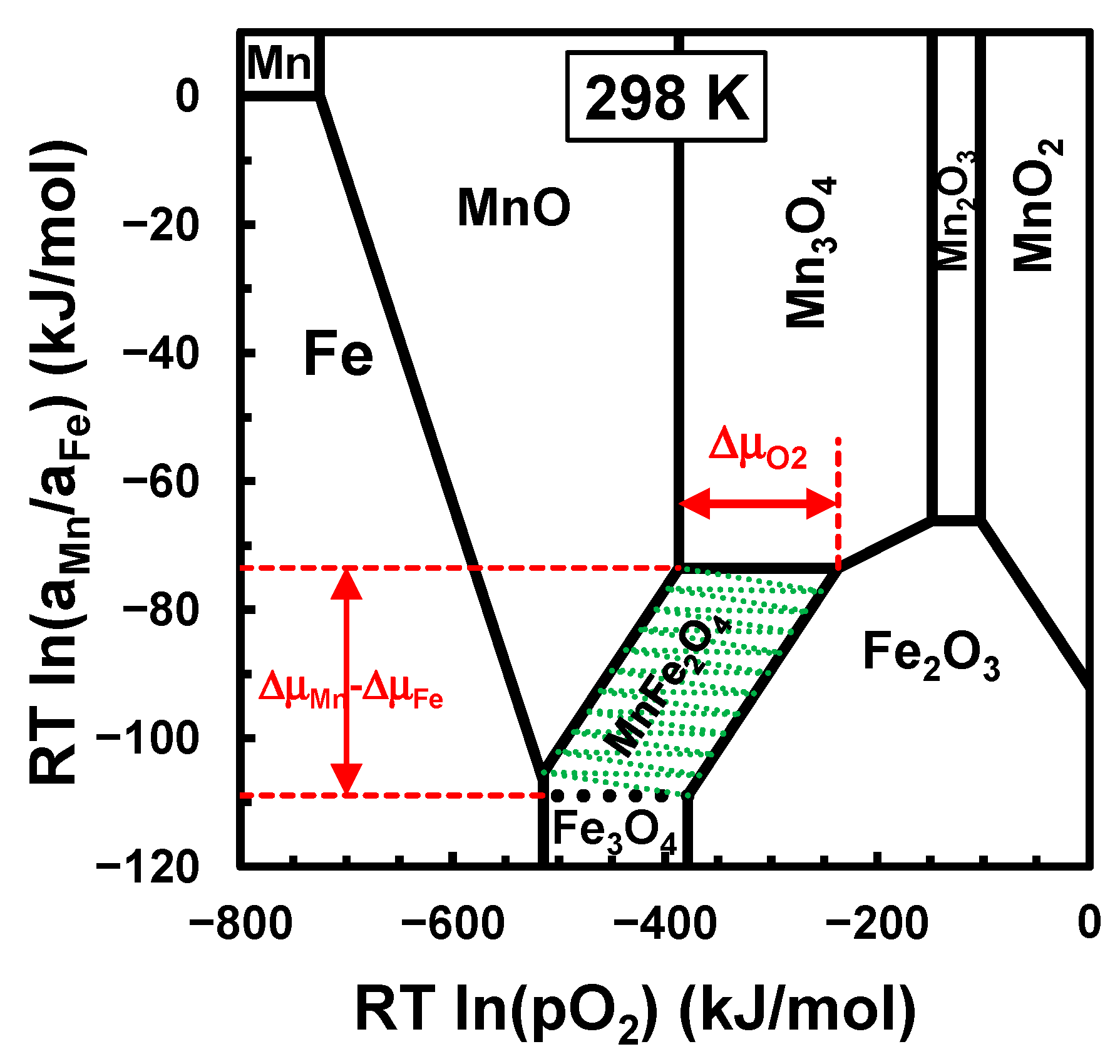
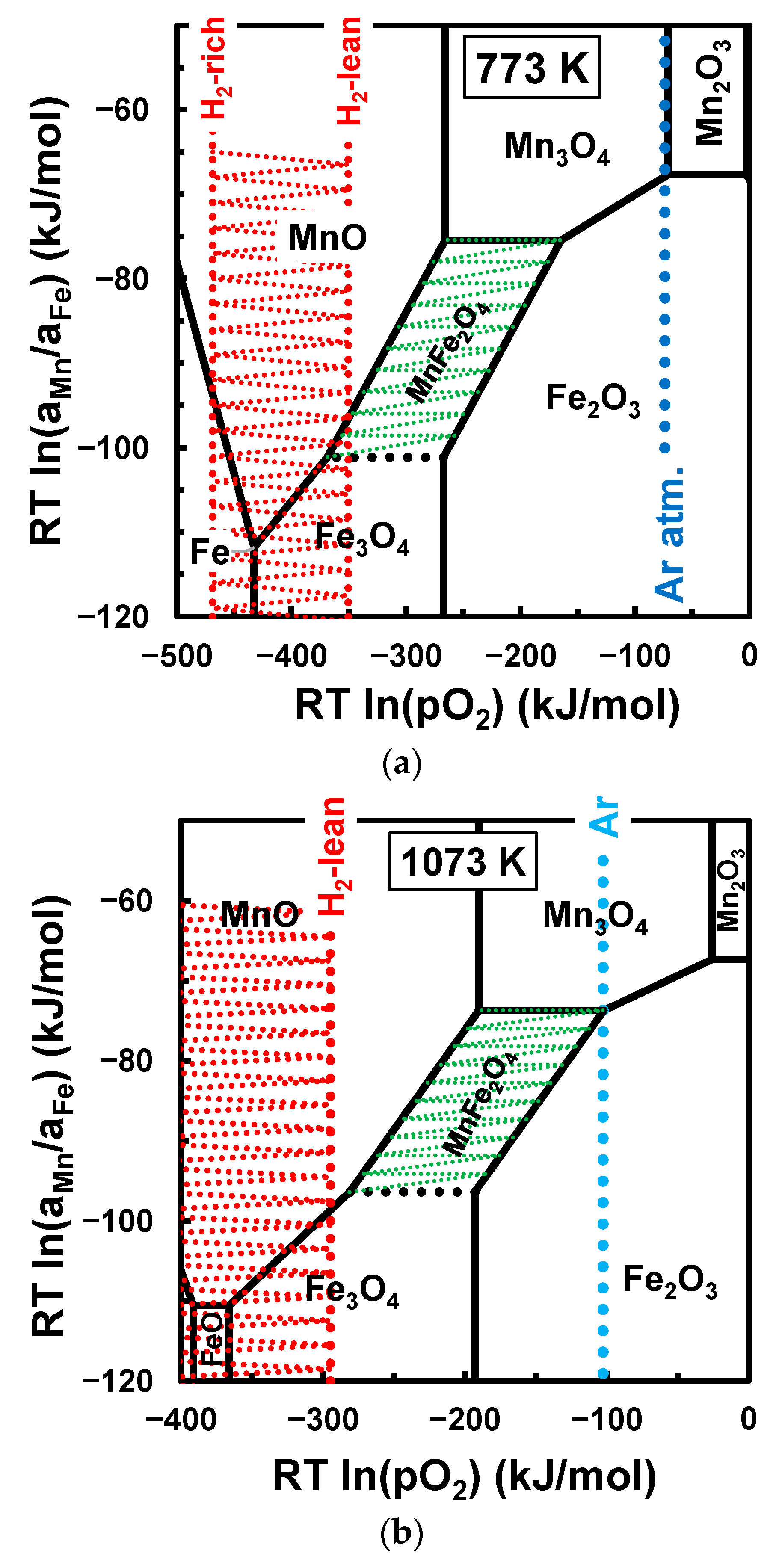

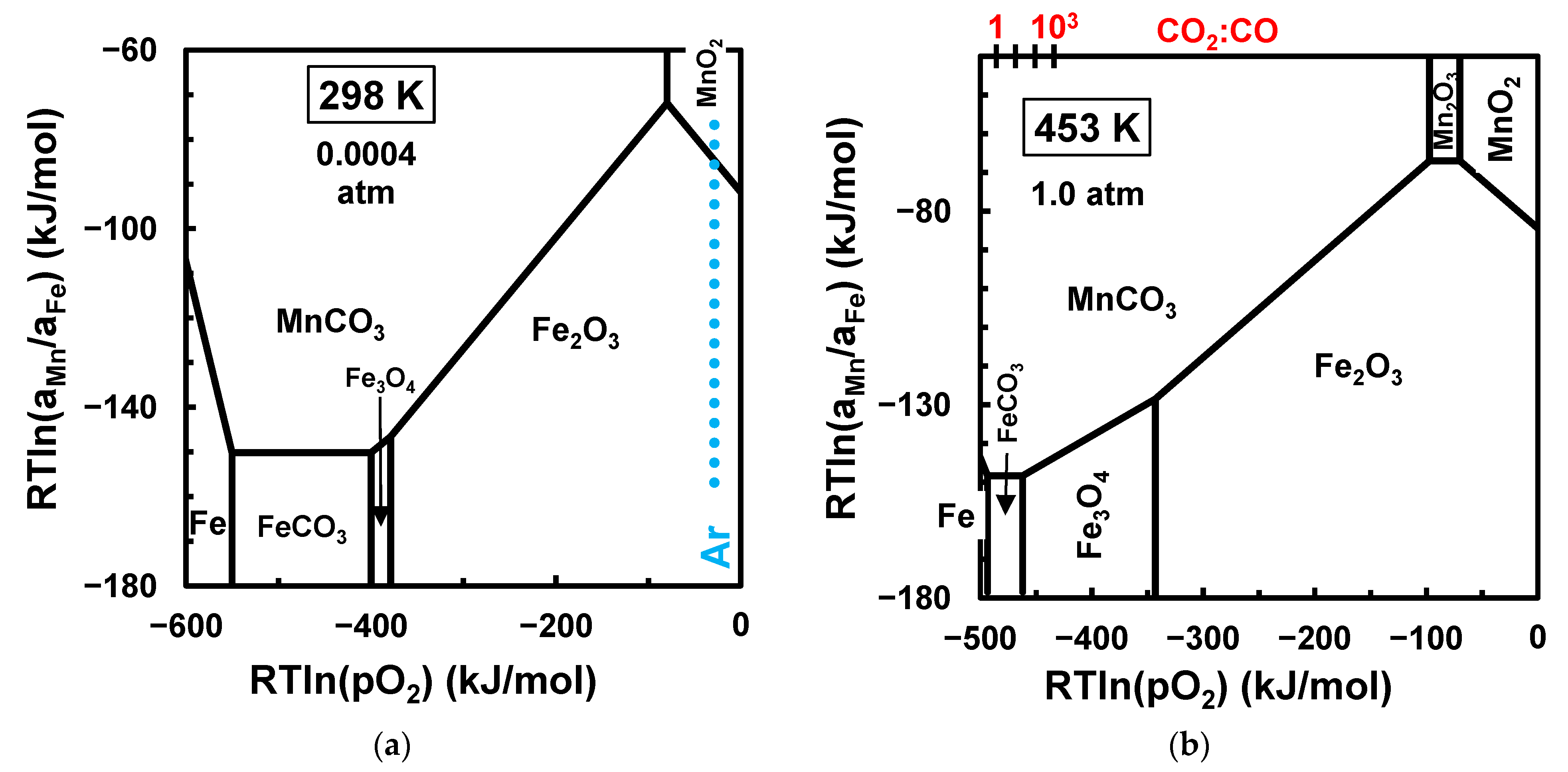
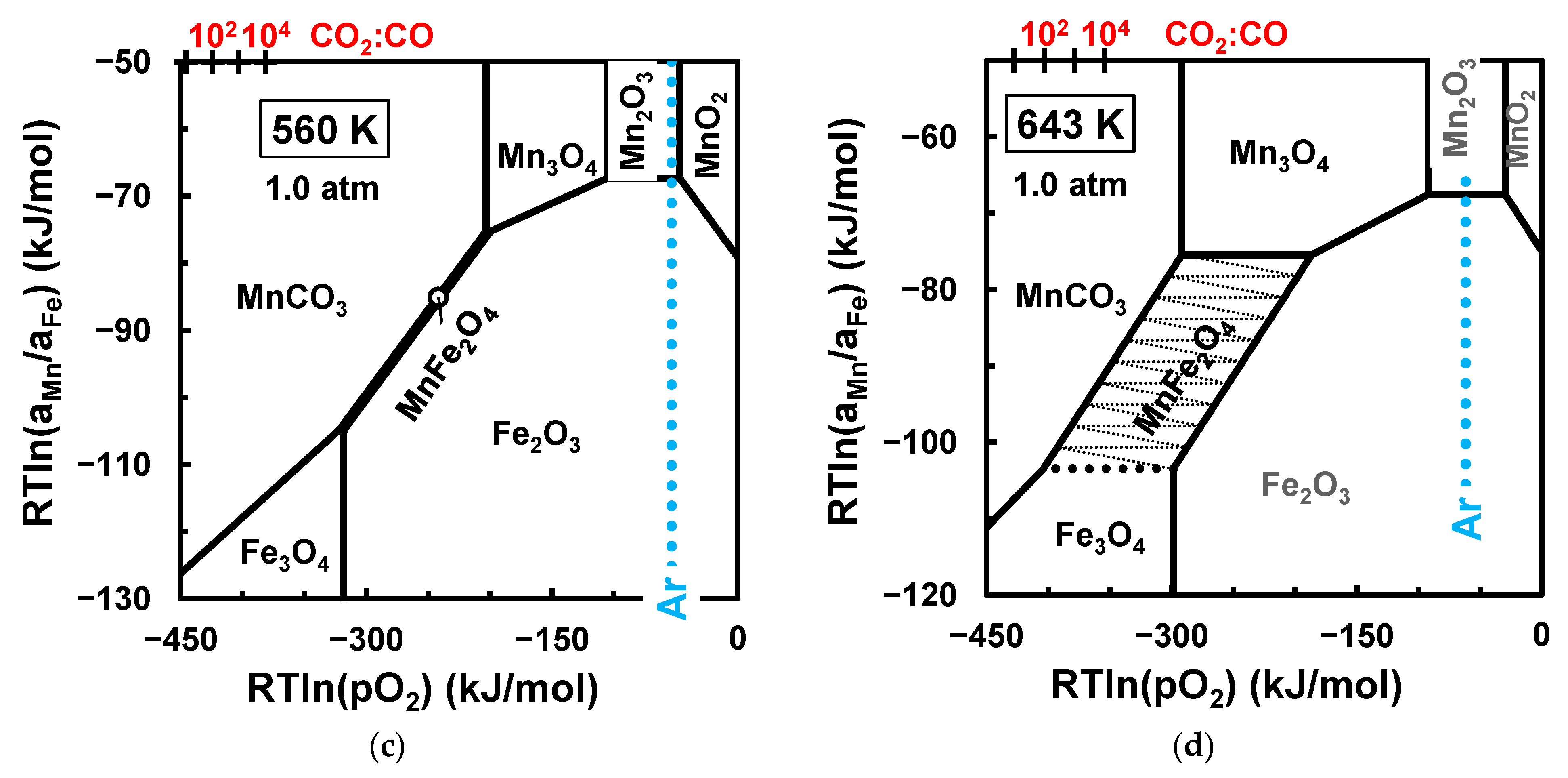
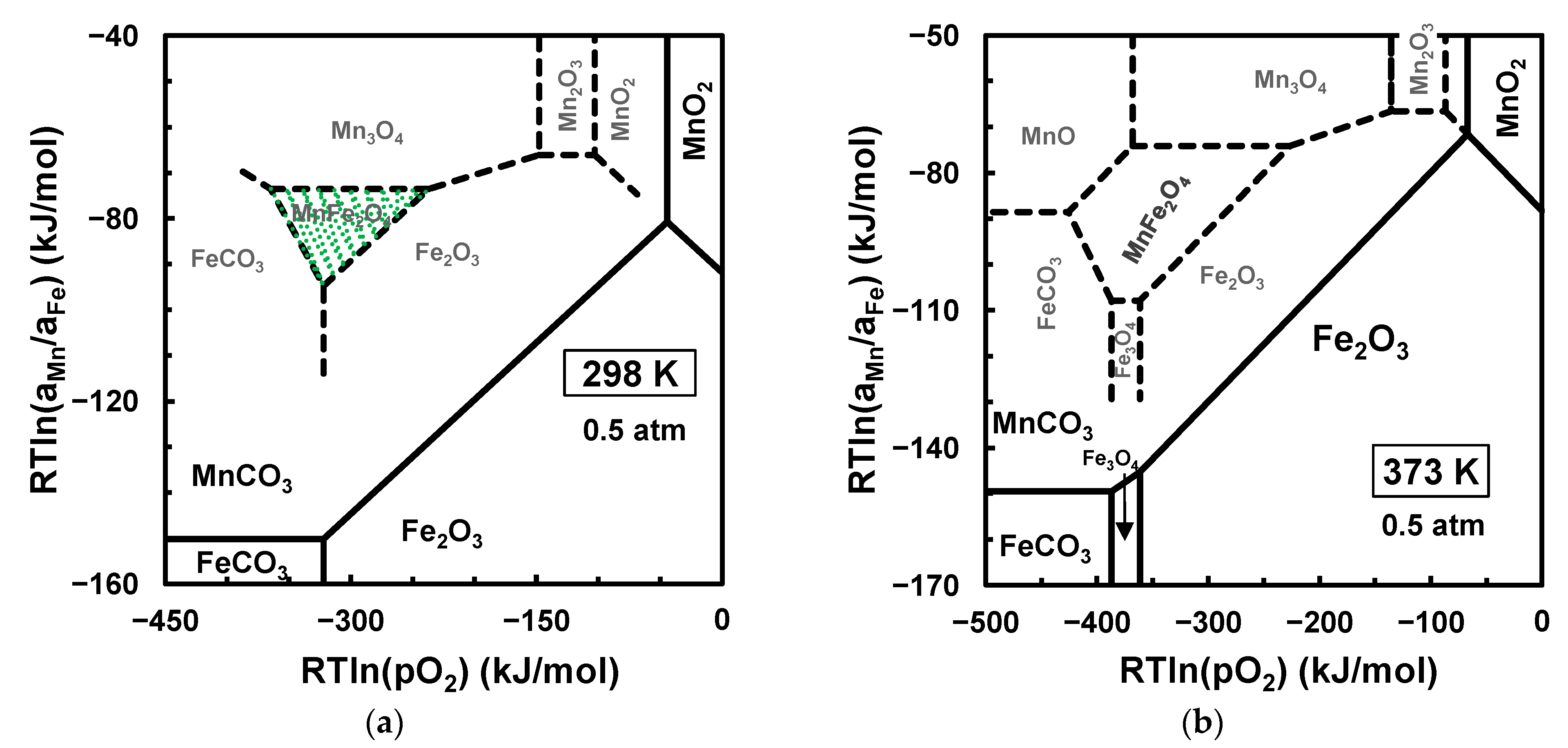
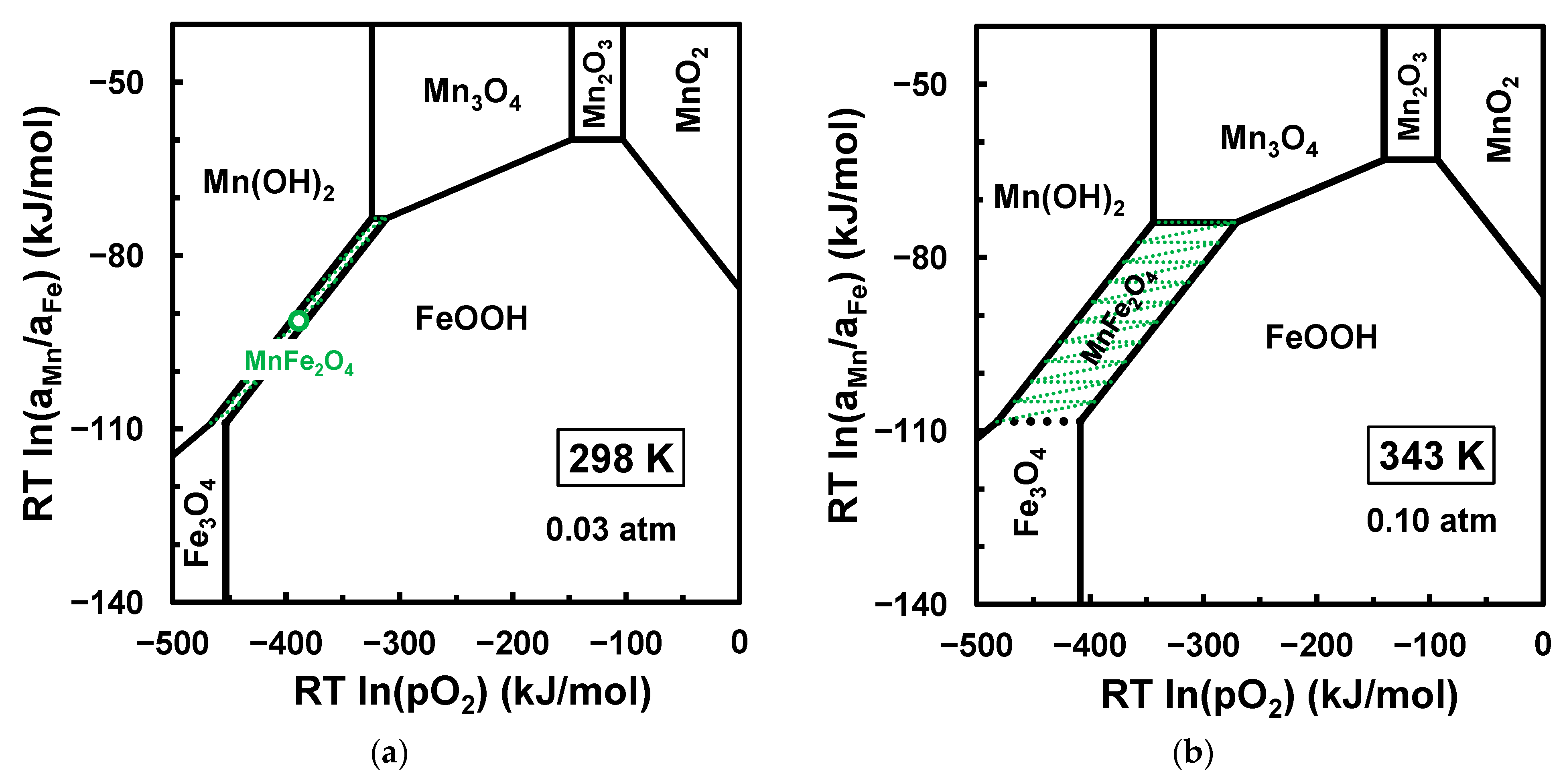
 ), (
), ( ), (
), ( ), (
), ( ) and Ni (
) and Ni ( ). The relative areas under the main reflection of (104), (200), and Ni (111), are shown in black, green, and red, respectively.
). The relative areas under the main reflection of (104), (200), and Ni (111), are shown in black, green, and red, respectively.
 ), (
), ( ), (
), ( ), (
), ( ) and Ni (
) and Ni ( ). The relative areas under the main reflection of (104), (200), and Ni (111), are shown in black, green, and red, respectively.
). The relative areas under the main reflection of (104), (200), and Ni (111), are shown in black, green, and red, respectively.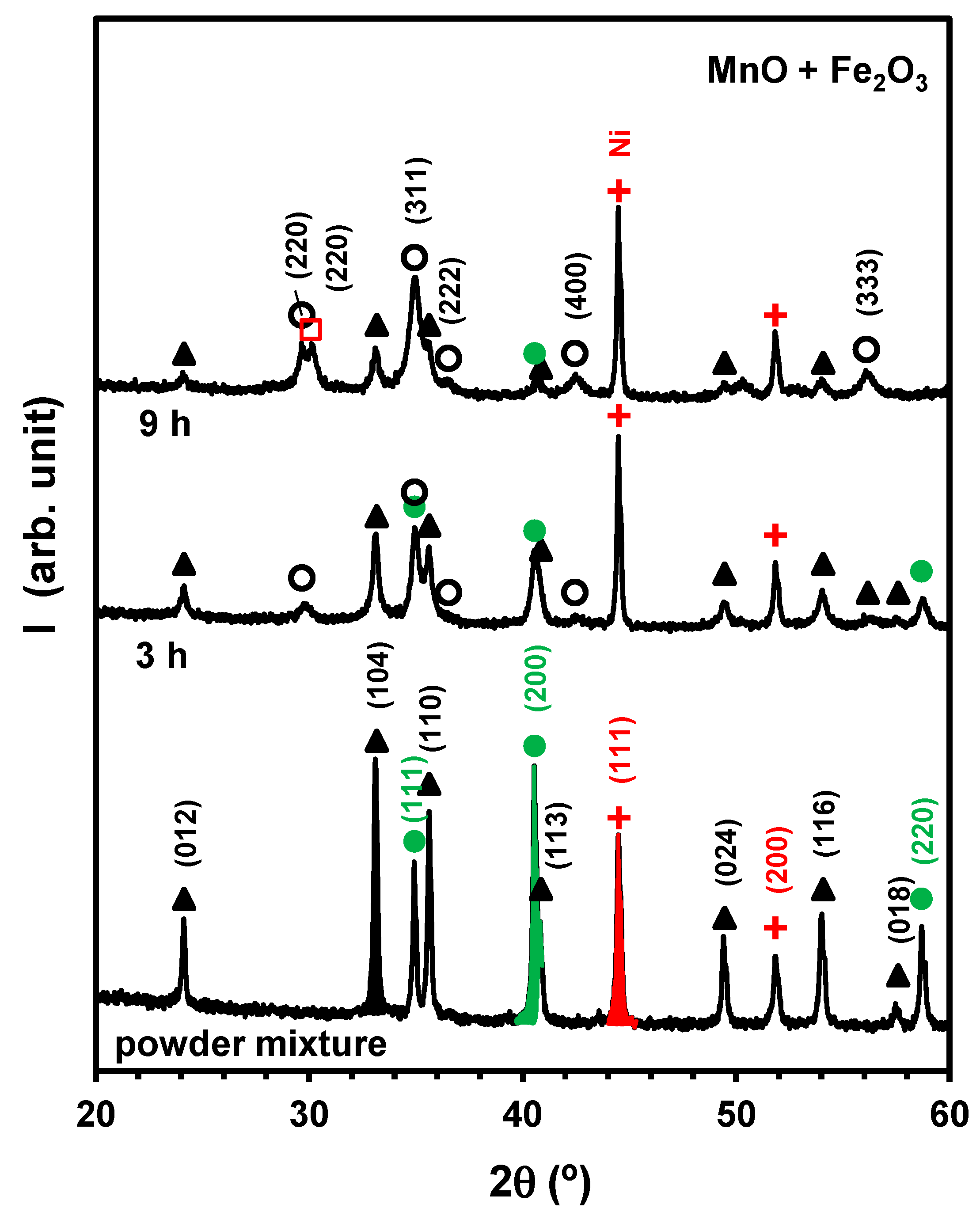
 ), (
), ( ), (
), ( ), and (
), and ( ).
).
 ), (
), ( ), (
), ( ), and (
), and ( ).
).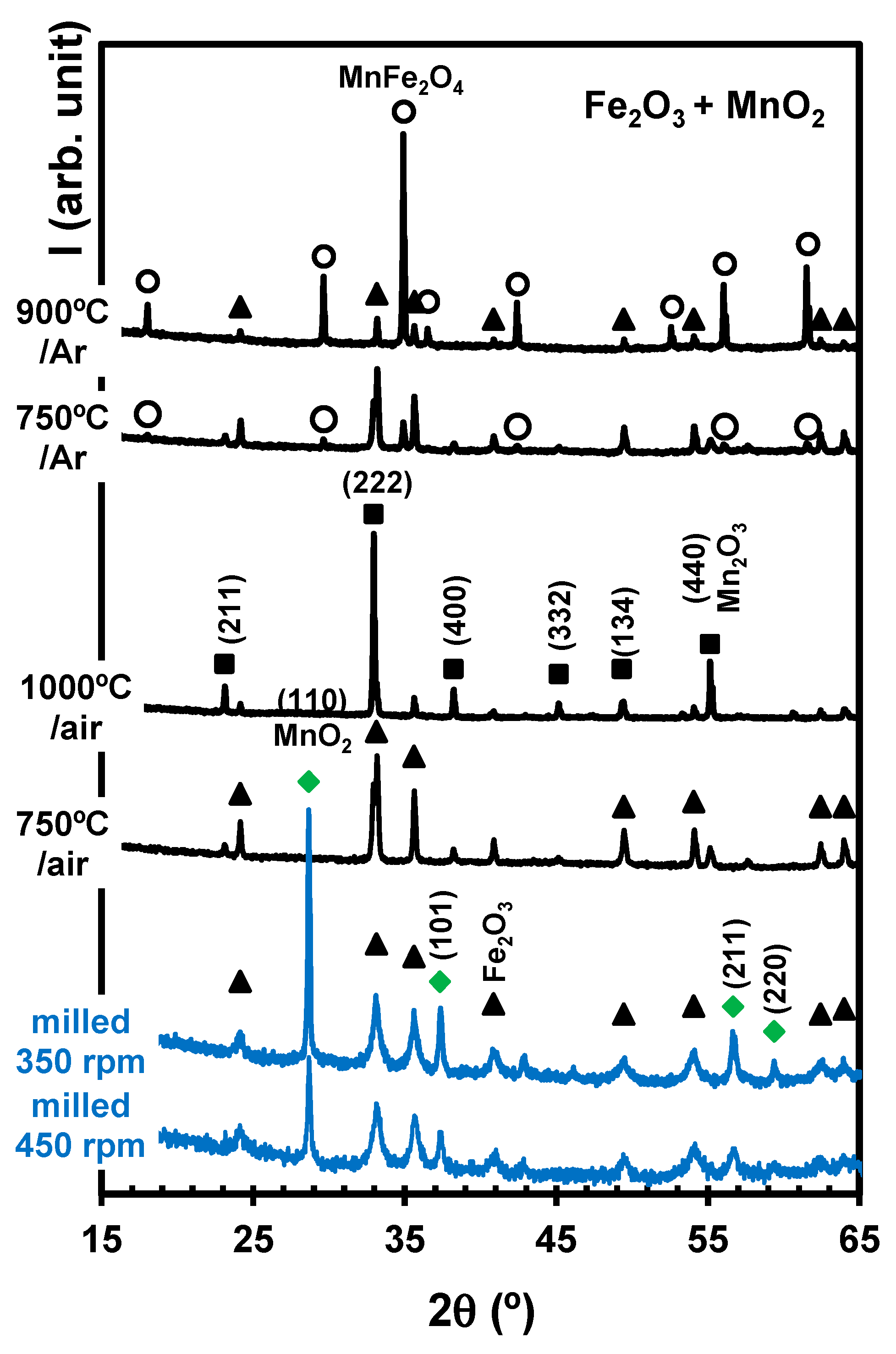
 ), (
), ( ) and (
) and ( ).
).
 ), (
), ( ) and (
) and ( ).
).
 ), (
), ( ), (
), ( ), (
), ( ), (
), ( ), and (
), and ( ).
).
 ), (
), ( ), (
), ( ), (
), ( ), (
), ( ), and (
), and ( ).
).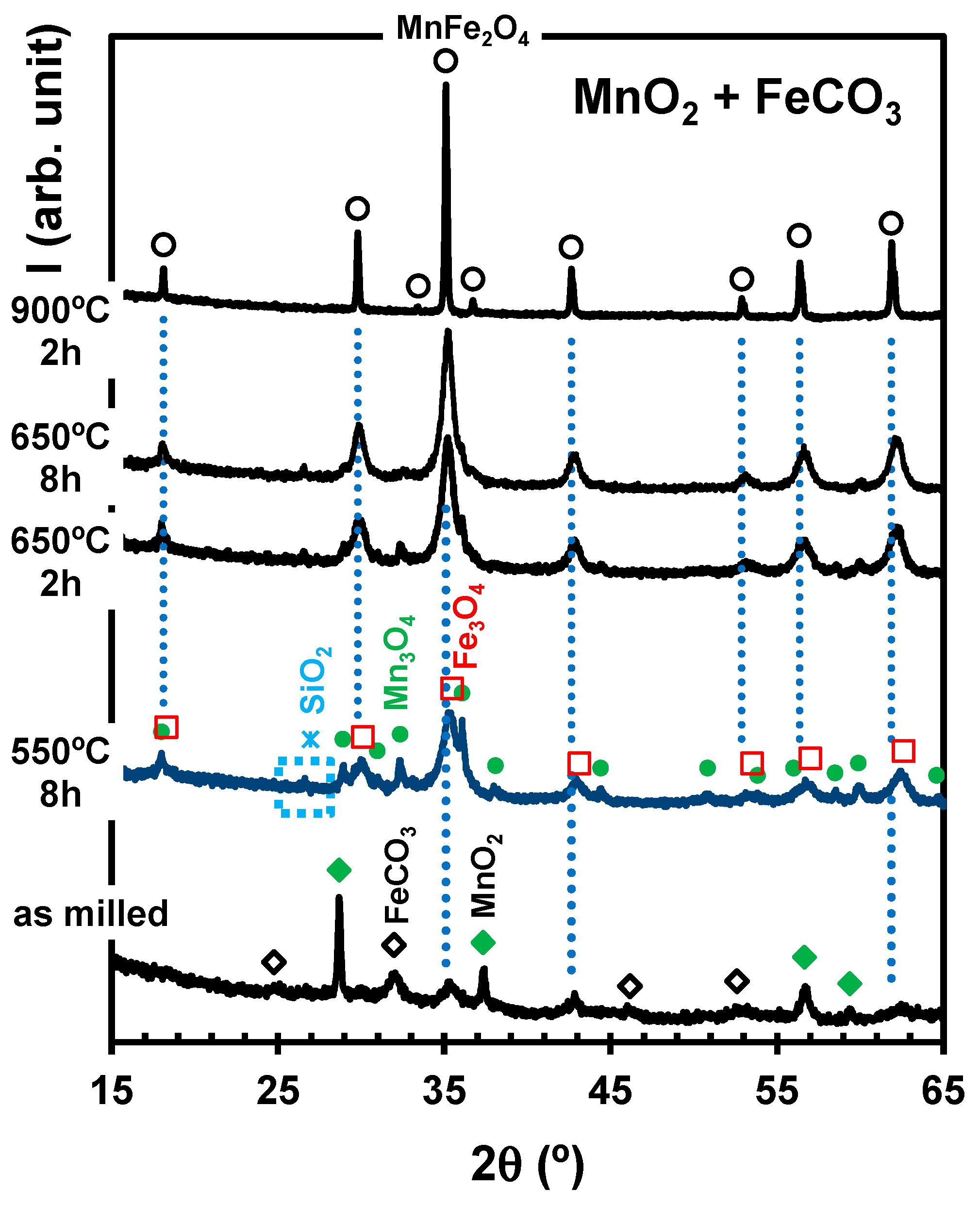
| Notation | Vial | % of Balls | Ball-to-Powder Weight Ratio | Rotation Speed | Effective Milling Time | Milling Time:Pause Time | |
|---|---|---|---|---|---|---|---|
| Material | 10 mm | 15 mm | (mballs:mpowder) | (rpm) | (min) | (min:min) | |
| 350 rpm | TZP | 100% | - | 7:1 | 350 | 600 | 5:5 |
| 450 rpm | TZP | 100% | - | 7:1 | 450 | 600 | 5:5 |
| TZP low | TZP | 92% | 8% | 7:1 | 450 | 600 | 5:5 |
| TZP high | TZP | 67% | 33% | 12:1 | 450 | 800 | 10:5 |
| Nylon | Nylon | 67% | 33% | 12:1 | 450 | 800 | 10:5 |
| Phase | wt.% | ||
|---|---|---|---|
| As-Milled | Milled | ||
| 3 h | 9 h | ||
| MnO | 31 | 15 | 2 |
| Fe2O3 | 69 | 37 | 16 |
| Others | − | 32 | 65 |
Disclaimer/Publisher’s Note: The statements, opinions and data contained in all publications are solely those of the individual author(s) and contributor(s) and not of MDPI and/or the editor(s). MDPI and/or the editor(s) disclaim responsibility for any injury to people or property resulting from any ideas, methods, instructions or products referred to in the content. |
© 2024 by the authors. Licensee MDPI, Basel, Switzerland. This article is an open access article distributed under the terms and conditions of the Creative Commons Attribution (CC BY) license (https://creativecommons.org/licenses/by/4.0/).
Share and Cite
Antunes, I.; Baptista, M.F.; Kovalevsky, A.V.; Yaremchenko, A.A.; Frade, J.R. Thermodynamic Guidelines for the Mechanosynthesis or Solid-State Synthesis of MnFe2O4 at Relatively Low Temperatures. Materials 2024, 17, 299. https://doi.org/10.3390/ma17020299
Antunes I, Baptista MF, Kovalevsky AV, Yaremchenko AA, Frade JR. Thermodynamic Guidelines for the Mechanosynthesis or Solid-State Synthesis of MnFe2O4 at Relatively Low Temperatures. Materials. 2024; 17(2):299. https://doi.org/10.3390/ma17020299
Chicago/Turabian StyleAntunes, Isabel, Miguel F. Baptista, Andrei V. Kovalevsky, Aleksey A. Yaremchenko, and Jorge R. Frade. 2024. "Thermodynamic Guidelines for the Mechanosynthesis or Solid-State Synthesis of MnFe2O4 at Relatively Low Temperatures" Materials 17, no. 2: 299. https://doi.org/10.3390/ma17020299
APA StyleAntunes, I., Baptista, M. F., Kovalevsky, A. V., Yaremchenko, A. A., & Frade, J. R. (2024). Thermodynamic Guidelines for the Mechanosynthesis or Solid-State Synthesis of MnFe2O4 at Relatively Low Temperatures. Materials, 17(2), 299. https://doi.org/10.3390/ma17020299







